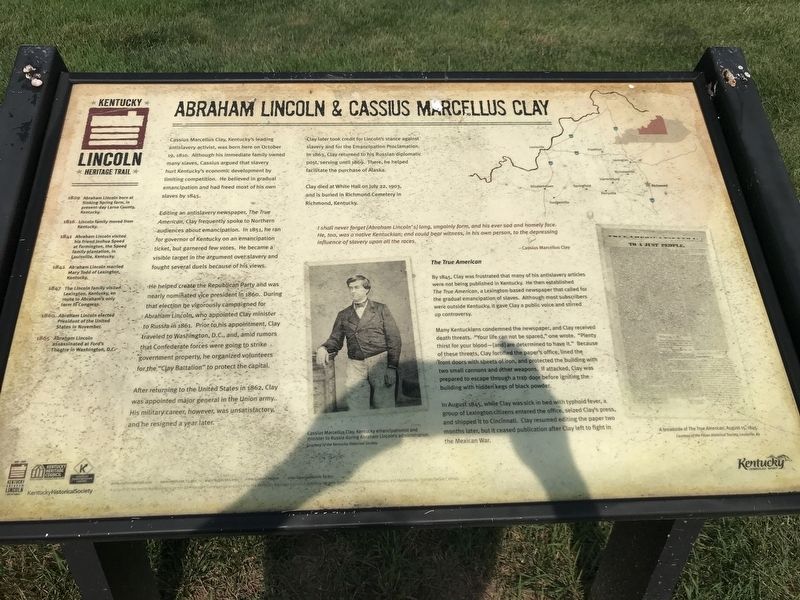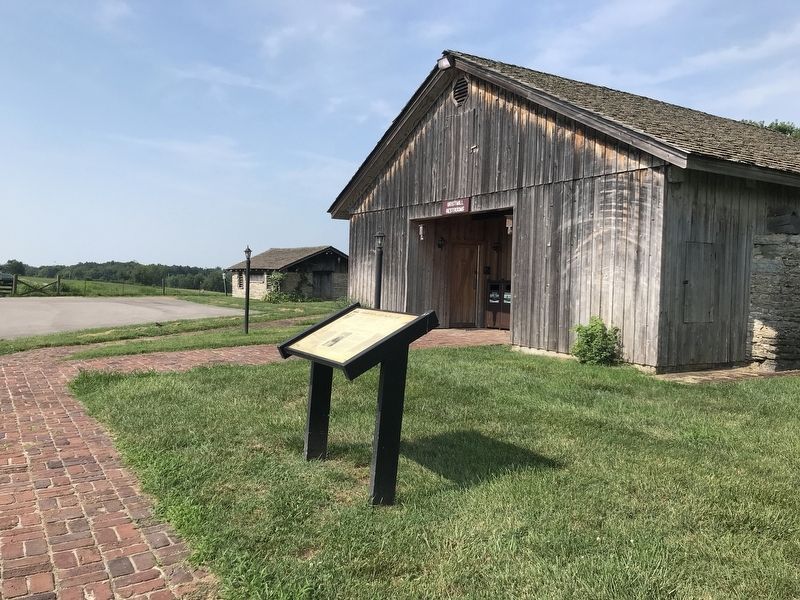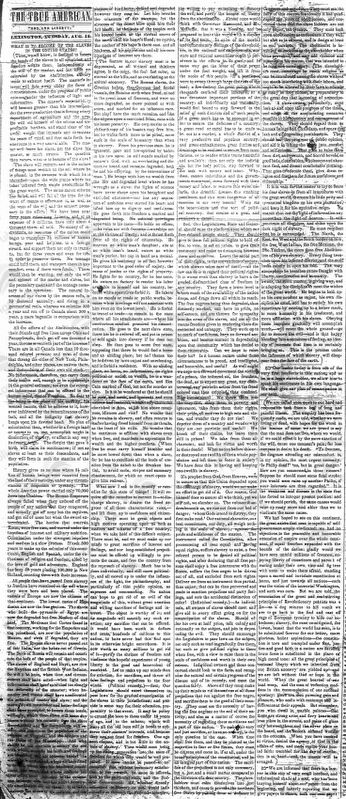Near Richmond in Madison County, Kentucky — The American South (East South Central)
Abraham Lincoln & Cassius Marcellus Clay
— Kentucky Abraham Lincoln Heritage Trail —
Inscription.
Cassius Marcellus Clay, Kentucky's leading antislavery activist, was born here on October 19, 1810. Although his immediate family owned many slaves, Cassius argued that slavery hurt Kentucky's economic development by limiting competition. He believed in gradual emancipation and had freed most of his own slaves by 1845.
Editing an antislavery newspaper, The True American, Clay frequently spoke to Northern audiences about emancipation. In 1851, he ran for governor of Kentucky on an emancipation ticket, but garnered few votes. He became a visible target in the argument over slavery and fought several duels because of his views.
He helped create the Republican Party and was nearly nominated vice president in 1860. During that election he vigorously campaigned for Abraham Lincoln, who appointed Clay minister to Russia in 1861. Prior to his appointment, Clay traveled to Washington, D.C., and, amid rumors that Confederate forces were going to strike government property, he organized volunteers for the “Clay Battalion” to protect the capital.
After returning to the United States in 1862, Clay was appointed major general in the Union army. His military career, however, was unsatisfactory, and he resigned a year later.
Clay later took credit for Lincoln's stance against slavery and for the Emancipation Proclamation. In 1863, Clay returned to his Russian diplomatic post, serving until 1869. There, he helped facilitate the purchase of Alaska.
Clay died at White Hall on July 22, 1903, and is buried in Richmond Cemetery in Richmond, Kentucky.
I shall never forget [Abraham Lincoln's] long, ungainly form, and his ever sad and homely face. He, too, was a native Kentuckian; and could bear witness, in his own person, to the depressing influence of slavery upon all the races. — Cassius Marcellus Clay
The True American
By 1845, Clay was frustrated that many of his antislavery articles were not being published in Kentucky. He then established The True American, a Lexington-based newspaper that called for the gradual emancipation of slaves. Although most subscribers were outside Kentucky, it gave Clay a public voice and stirred up controversy.
Many Kentuckians condemned the newspaper, and Clay received death threats. “Your life can not be spared,” one wrote. “Plenty thirst for your blood–[and] are determined to have it.” Because of these threats, Clay fortified the paper's office, lined the front doors with sheets of iron, and protected the building with two small cannons and other weapons. If attacked, Clay was prepared to escape through a trap door before igniting the building with hidden kegs of black
powder.
In August 1845, while Clay was sick in bed with typhoid fever, a group of Lexington citizens entered the office, seized Clay's press, and shipped it to Cincinnati. Clay resumed editing the newspaper two months later, but it ceased publication after Clay left to fight in the Mexican War.
Captions (left to right)
• Cassius Marcellus Clay, Kentucky emancipationist and minister to Russia during Abraham Lincoln's administration. Courtesy of the Kentucky Historical Society
• A broadside of The True American, August 15, 1845. Courtesy of the Filson Historical Society, Louisville, Ky.
Timeline
• 1809 Abraham Lincoln born at Sinking Spring farm, in present-day Larue County, Kentucky.
• 1816 Lincoln family moved from Kentucky.
• 1841 Abraham Lincoln visited his friend Joshua Speed at Farmington, the Speed family plantation, in Louisville, Kentucky.
• 1842 Abraham Lincoln married Mary Todd of Lexington, Kentucky.
• 1847 The Lincoln family visited Lexington, Kentucky, en route to Abraham's only term in Congress.
• 1860 Abraham Lincoln elected President of the United States in November.
• 1865 Abraham Lincoln assassinated at Ford's Theatre in Washington, D.C.
Erected by
Kentucky Abraham Lincoln Heritage Trail • Kentucky Heritage Council • Kentucky Historical Society • Kentucky Transportation Cabinet.
Topics and series. This historical marker is listed in these topic lists: Abolition & Underground RR • Communications • Government & Politics. In addition, it is included in the Former U.S. Presidents: #16 Abraham Lincoln series list. A significant historical date for this entry is October 19, 1810.
Location. 37° 49.935′ N, 84° 21.081′ W. Marker is near Richmond, Kentucky, in Madison County. Marker can be reached from White Hall Shrine Road (Kentucky Route 3055) 0.4 miles south of Fox Town Road. The marker is near the restroom building in White Hall State Historic Site. Touch for map. Marker is at or near this postal address: 500 White Hall Shrine Rd, Richmond KY 40475, United States of America. Touch for directions.
Other nearby markers. At least 8 other markers are within 2 miles of this marker, measured as the crow flies. White Hall State Historic Site (a few steps from this marker); Kentucky & the Emancipation Proclamation (a few steps from this marker); Mary Barr Clay (within shouting distance of this marker); Laura Clay (1849-1941) (within shouting distance of this marker); White Hall (about 400 feet away, measured in a direct line); Richmond Garden Club (about 500 feet away); Stone Kitchen (about 700 feet away); “Lion of White Hall” (approx. 1.3 miles away). Touch for a list and map of all markers in Richmond.
Credits. This page was last revised on July 27, 2022. It was originally submitted on July 26, 2022, by Duane and Tracy Marsteller of Murfreesboro, Tennessee. This page has been viewed 635 times since then and 147 times this year. Last updated on July 26, 2022, by Bradley Owen of Morgantown, West Virginia. Photos: 1, 2, 3. submitted on July 26, 2022, by Duane and Tracy Marsteller of Murfreesboro, Tennessee. • J. Makali Bruton was the editor who published this page.


